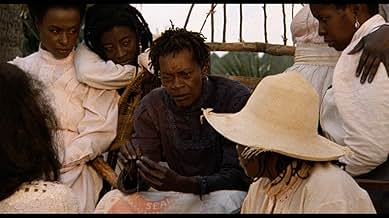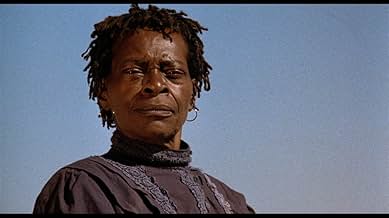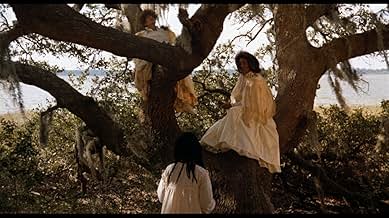IMDb रेटिंग
6.6/10
3.6 हज़ार
आपकी रेटिंग
अपनी भाषा में प्लॉट जोड़ेंA languid, impressionistic story of three generations of Gullah women living on the South Carolina Sea Islands in 1902.A languid, impressionistic story of three generations of Gullah women living on the South Carolina Sea Islands in 1902.A languid, impressionistic story of three generations of Gullah women living on the South Carolina Sea Islands in 1902.
- पुरस्कार
- 4 जीत और कुल 2 नामांकन
Barbara O
- Yellow Mary
- (as Barbara-O)
Tony King
- Newlywed Man
- (as Malik Farrakhan)
फ़ीचर्ड समीक्षाएं
I really wanted to like this, but other than visually, there wasn't much to appreciate. A stronger storyline would have been nice.
It does however inspire me to visit the area and look into the history, but I wish the movie itself had told me more.
Kudos for the effort.
It does however inspire me to visit the area and look into the history, but I wish the movie itself had told me more.
Kudos for the effort.
"Daughters of the Dust" isn't an easy work, but it's a very fine accomplishment, and one of the most important African American films of the last 20 years.
Julie Dash has chosen to share with her audience a chapter of black history that is still new to most white Americans, the internal issues that came with Black Americans as they made their way North in the years between 1900 and 1920. The separation from the soil, the divorce from those remnants of West African culture that survived through the holocaust of slavery. The psychic tearing of the transition from rural to urban culture. The skin game that Yellow Mary and other "fair skinned" Black people had to play in order to survive in White America. If the film is boring to many, let it be plainly said that it is boring for many because the film maker courageously chose to examine a piece of history that most White Americans- and many Black ones- no longer care much about.
If you want to be entertained, this isn't a film you'll enjoy. "Daughters of the Dust" offers instead an opportunity to probe deep, to look close at the dreamy quality of an internal life, and a balanced relationship with the earth, that most of our peoples in the United States have chosen to leave behind them for exactly the wrong reasons. Let those who have difficulty thinking about these things stick to action films. "Daughters of the Dust" is about something more akin to the sense of wonder that's being rapidly stamped out of many of us in the name of mom, apple pie, and the gross national product. It is worth not one, but many viewings. Julie Dash has created a masterpiece of American cinema.
Julie Dash has chosen to share with her audience a chapter of black history that is still new to most white Americans, the internal issues that came with Black Americans as they made their way North in the years between 1900 and 1920. The separation from the soil, the divorce from those remnants of West African culture that survived through the holocaust of slavery. The psychic tearing of the transition from rural to urban culture. The skin game that Yellow Mary and other "fair skinned" Black people had to play in order to survive in White America. If the film is boring to many, let it be plainly said that it is boring for many because the film maker courageously chose to examine a piece of history that most White Americans- and many Black ones- no longer care much about.
If you want to be entertained, this isn't a film you'll enjoy. "Daughters of the Dust" offers instead an opportunity to probe deep, to look close at the dreamy quality of an internal life, and a balanced relationship with the earth, that most of our peoples in the United States have chosen to leave behind them for exactly the wrong reasons. Let those who have difficulty thinking about these things stick to action films. "Daughters of the Dust" is about something more akin to the sense of wonder that's being rapidly stamped out of many of us in the name of mom, apple pie, and the gross national product. It is worth not one, but many viewings. Julie Dash has created a masterpiece of American cinema.
Daughters of the Dust directed by Julie Dash is a cultural perspective look into the lives of an African American family left on an island years after being torn from their heritage of Africa for slavery only to have revolted and be left to themselves, stranded on the island off the coast of the Southern eastern coast and the family who live off the island with others who long to find their heritage. The film's story line is developed in the one day where the family is getting ready to head to a new world on the main land. The internal conflict of the family between relatives who no longer live on the island who have become part of the culture of America post civil war and the family left on the island that live by the old heritage and customs. The family on the island struggle between their history and culture to the change of the times and the need for conformity. This film centers on the generations of the family from the young children who are filled with life then to the adults who are torn between their decisions to leave to finally the center character, the elder grandmother of the family Nana. Nana's ways and beliefs that have been accepted by the family their entire lives are now the only thing holding the family back from their future off the island. The film focuses largely on the women of the family, displaying the differences of ones who that have lived on the island and then those whom have lived off it. The lines divided between the two are evidently shown throughout the film. The women who lived off the island no longer take to heart their heritage that Nana lives by. They find it to be uncivilized and against the teaching of the bible. There is the scene in which the family after much struggle and torment accept Nana's decision to stay and her heritage. The scene is of the entire family gathered around the grandmother in which she has a lock of her hair and others placed on a bible asking everyone to believe in the old ways and take her with her by kissing the hair and bible. Finally, the scene acts as importance because one of the outside family members whom diligently preaches and believes in Christianity gives in to Nana's request.
Daughters of the Dust cannot be explained without stating the mise en cinema. From the clothing to the shots of the landscape of the island all resemble the time and place of the film. Not only the background and clothes, but also the character themselves turn this limited distributed film into a believable representation of what people of this time would act and be. The storyline background of the slavery uprising actually having taken place on the island gives it enormous creditability. The shots of the island start the creditability of the film with shots of the women interacting with the water of the ocean and the rivers, the shots of the forest and trees, and finally the most significant may be when the women are preparing the dinner showing how their food is prepared with live seafood and spices gathered from the island. The mise en cinema is creditable because of the clothes as well; from Nana who has only a dress is indigo, which was the main produce to harvest by the slaves on the island to the white Victorian dress of the women from the main land.
Dash's Daughters of the Dust cannot be denied as a cultural perspective that's originality has touched on the transition to the new culture of African Americans and they past that many have forgotten after the postwar civil war era. Its cultural insight may have been directed to a certain selected target audience, but its look into the heritage of the people cannot be viewed as anything but a respectable insight of the times.
Daughters of the Dust cannot be explained without stating the mise en cinema. From the clothing to the shots of the landscape of the island all resemble the time and place of the film. Not only the background and clothes, but also the character themselves turn this limited distributed film into a believable representation of what people of this time would act and be. The storyline background of the slavery uprising actually having taken place on the island gives it enormous creditability. The shots of the island start the creditability of the film with shots of the women interacting with the water of the ocean and the rivers, the shots of the forest and trees, and finally the most significant may be when the women are preparing the dinner showing how their food is prepared with live seafood and spices gathered from the island. The mise en cinema is creditable because of the clothes as well; from Nana who has only a dress is indigo, which was the main produce to harvest by the slaves on the island to the white Victorian dress of the women from the main land.
Dash's Daughters of the Dust cannot be denied as a cultural perspective that's originality has touched on the transition to the new culture of African Americans and they past that many have forgotten after the postwar civil war era. Its cultural insight may have been directed to a certain selected target audience, but its look into the heritage of the people cannot be viewed as anything but a respectable insight of the times.
A Feast For the Eyes, Ears, And Heart, March 26, 2001 Reviewer: Angela Jefferson (see more about me) from Memphis, Tn USA In the opening of her film, Daughters of the Dust, Julie Dash alerts the viewer that this is no ordinary African American story. Conversely, this is an American history lesson with African origins. A small informative note at the start of the film puts the entire movie in context. Without this explanatory foreword, many viewers would probably find the film hard to understand. Though the movie tells the story of the Peazant family's migration from the sea islands of the South, the story also gives a panoramic view of the Gullah culture at-large. Because the islands are isolated from the mainland states, the Gullah retain a distinct African ethnicity and culture. Ironically, the Peazants want to rid themselves of the old ways and heritage, thus beginning an exodus from the islands to the mainland. Taking place in 1902, just fifty years after the end of slavery, Daughter of the Dust explores the Peazant's struggle for survival and escape from poverty. The movie opens on the eve of the family's great migration to the mainland. A family celebration and farewell-of-sorts take place on the beach. The Peazants even hire a photographer to document this momentous occasion. As the movie progresses, the complexity of the family's departure from the island emerges. Difference and changing values mire the pending migration with conflict and strife. As the family prepares to leave, in search of a new life and better future, the film reveals the richness of the Gullah heritage. Narrations of "the unborn child" of Eli and Eula Peazant offer glimpses into problems the family has faced since their existence on the island. As explained by matriarch Nana Peazant, the Gullah are like "two people in one body." Though most Peazants were born in the Americas, their African heritage is forever evident. The internal conflicts of this duality haunt the family as they become ensnarled in battle, only to war against themselves. Through old African customs and rituals, such as glass bottle trees, salt water baths, and herb potions, Nana wants to ensure that the family stays together. Moreover, Nana, "the last of the old," has chosen to stay on the island. She celebrates everything that makes her who she is: the ugly and the good. She knows slavery and she knows freedom. Her life revolves around the continuation and strengthening of the Peazant family. Her rituals are often unappreciated and looked upon with scorn by other family members. Some family members are unwilling to grasp Nana's teachings and wisdom. They want to escape the island, to run away from the Gullah way of life. However, they cannot run from themselves. Just as Nana proclaims, they will always live a double life, no matter where they go. The trip to the mainland certainly cannot rid their indigo stained hands of its blue-blackish tint. Nor can the northern journey erase the memories of whom or what they are leaving. Unbeknownst to the younger Peazants, the duality, the recollections and remembrances, and the old way and traditions are gifts from their ancestors. Sadly, few are able to accept these gifts or comprehend their importance. Through authentic Gullah dialect, vivid imagery and colorful characters, Dash reveals the uniqueness of the Gullah people. A cousin, Yellow Mary, returns from Cuba to the island, facing the scorn of her people because she is a "ruint 'oman." Haggar, a bitter woman who wants nothing to do with the old Gullah ways, does not realize that she cannot rid herself of whom she is. For example, she despises the "old Africans," yet retains their ways in her speech and use of African colloquialisms. Another cousin, Viola is full of Christian religious fervor and against the heathen practices and nature-worshiping traditions of her people. Eula, who gives a heart- wrenching soliloquy at the end of the movie, bears the burden of pregnancy and rape by a white man. Eli, Eula's husband, represents the strength and future of the Peazant clan. Besides being adept at character development, Julie Dash effectively educates the viewer about African-American history. Tales of flying Africans, water-walking Ibo, Islamic religion, and slave trading are skillfully woven in small snatches throughout the film. We also see connections between African-Americans and Native Americans. The lessons learned from this film are too numerous. One must see the film more than once to appreciate all the information presented. Daughters of the Dust awakens all the senses. The beautiful cinematography transports viewers to a surreal place and time, creating a visual paradise. Each scene makes its introduction with mesmerizing African music, which aptly fits each setting. As the Gullah women prepare food for the feast, one cannot help but imagine the taste and smell of gumbo, shrimp, and crab. This movie also arouses the heart. One can easily identify and empathize with the characters' passion and sincerity. Often, the characters relay sentiments and convictions so convincingly, that it is hard to believe that the players were acting. Understanding complete passages is often difficult because of the beautiful and authentic tonality of the language. Nonetheless, the use of standard English could not have conveyed Dash's message as successfully. We should appreciate this film for its originality and courage. Stories such as these are hardly ever told. Most films neglect the eclectic nature of the African American community, usually focusing on only aspects that are familiar to the masses. Here, Julie Dash reaches beyond the boundaries that are set for African-American films. Equally as important is her ability and willingness to validate the African-American experience. She eloquently and subtly deals with difficult subjects such as slavery, self-hatred, feminism, color prejudices, and rape. Dash does not throw one viewpoint in your face. Conversely, Dash gives the viewer a front row seat into the lives of a remarkable people. We are then left to draw conclusions for ourselves. One feels liberated, proud, and honored to be allowed a window into their lives. The movie is a celebration of the African-American diaspora. The images, language, and music of Daughters of the Dust will linger in the minds of its fortunate viewers forever.
I saw this film for a film class at UF. We have seen some slow and some fast-paced films. This is by far the slowest we have seen and is the most boring piece of cinema I have ever seen.
Now, it's not ALL bad. The movie has some cultural significance and was obviously researched before filming. The shot selection was very good, colors vibrant, and you could feel the actors' emotions.
But the story... was slow. There's a load of characters and I couldn't figure out who was related to who and what all had happened with the pregnant woman. The movie was like the opening title-card sequence to Black Hawk Down stretched out to 2 hours in length. There's parts with loads of music and no dialogue and vice versa. The movie seemed to reach an ending 5 times before it finally did. The writer-director clearly had no clue as to what pacing was.
The story was basically about some African-Americans at the turn of the century who boat down to their family on the shores of some island that is separated on one side by a river and the ocean on the other. They want a better life and are split about whether the island or the mainland is the better spot for it. It takes them two agonizing (to us) hours to decide.
Long [very long] story short: half the class walked out in the first hour. And I was jealous of those who did when I reached the end of the film. 2/10
Now, it's not ALL bad. The movie has some cultural significance and was obviously researched before filming. The shot selection was very good, colors vibrant, and you could feel the actors' emotions.
But the story... was slow. There's a load of characters and I couldn't figure out who was related to who and what all had happened with the pregnant woman. The movie was like the opening title-card sequence to Black Hawk Down stretched out to 2 hours in length. There's parts with loads of music and no dialogue and vice versa. The movie seemed to reach an ending 5 times before it finally did. The writer-director clearly had no clue as to what pacing was.
The story was basically about some African-Americans at the turn of the century who boat down to their family on the shores of some island that is separated on one side by a river and the ocean on the other. They want a better life and are split about whether the island or the mainland is the better spot for it. It takes them two agonizing (to us) hours to decide.
Long [very long] story short: half the class walked out in the first hour. And I was jealous of those who did when I reached the end of the film. 2/10
क्या आपको पता है
- ट्रिवियाSelected to the Library of Congress National Registry of Film in 2004.
- भाव
[first lines]
Nana Peazant: I am the first and the last. I am the honored one and the scorned one. I am the whore and the holy one. I am the wife and the virgin. I am the barren one and many are my daughters. I am the silence that you can not understand. I am the utterance of my name.
टॉप पसंद
रेटिंग देने के लिए साइन-इन करें और वैयक्तिकृत सुझावों के लिए वॉचलिस्ट करें
- How long is Daughters of the Dust?Alexa द्वारा संचालित
विवरण
बॉक्स ऑफ़िस
- US और कनाडा में सकल
- $16,83,422
- US और कनाडा में पहले सप्ताह में कुल कमाई
- $10,842
- 20 नव॰ 2016
- दुनिया भर में सकल
- $16,89,776
- चलने की अवधि1 घंटा 53 मिनट
- रंग
- पक्ष अनुपात
- 1.85 : 1
इस पेज में योगदान दें
किसी बदलाव का सुझाव दें या अनुपलब्ध कॉन्टेंट जोड़ें






























